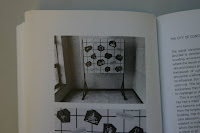3) Repetition; repeating or mimicking opposing points, spatial traversals, contingencies that are already present in the archive in my day to day environment. Includes: studio, storage space. (kind of complex)

(from left to right)
Digital print job-square Enschede 2o07,
A2 glossy paper grey,
A1 copy plan Social Service Enschede 1969,
perforated board,
lab stool,
MDF board grey,
tripod,
window half-opened.

View from my studio window, Hengelo, 2009.
1) The porosity of time.
Following the grid through different topologies/ time: Exhibition '1940-1945' in the basement of the Social Service, Nijmegen, 1969 - Documentation of Steven Willats displays (He still makes use of the same display strategies for his schemes and grids as he did in the 60's.) - The job-square in Enschede where the grid is applied on walls with a decorative function. - The use of the grid in my studio and Artis.







I have thousand of these images, but haven't found a way to work with Picasa albums yet, I would like to put some restriction on their public accessibility.
2) Color coding, possibly material listing (reflection, absorption) and sort of lighting (daylight, artificial), because these conditions affect the colors naturally:
- Social Service 1986 (Leiden): television tube colors; blue, green, red.
- The archive dossiers (Amsterdam); pale- brown, green, pink.
- Depository (Nijmegen): apple green, artificial light: fluorescent daylight and warmlight.
- Job-square (Enschede): orange, others use bright colors like; apple green, magenta, blue
- Studio (Hengelo/Maastricht): grey, white, beige (considered neutral colors)



Perhaps this is a good handhold for you (Andreas) to work with?







